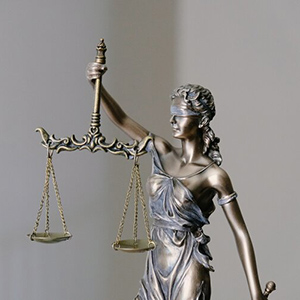
You are getting ready for a court case, either representing yourself or talking to your lawyer about things that you think the court should know. Documents or information submitted to the court are called evidence. There are rules about what types of things the court will actually consider. These rules are governed by Federal and State laws. We will be discussing what evidence can be presented as governed by the Federal Rules of Evidence—as most of the states follows some version of the Federal Rules—and the Rules of Evidence in Kansas and Missouri.
There are six basic things that courts look at when deciding if they can consider a piece of evidence. These six things are simply a beginning, and not a comprehensive list. Nevertheless, these six questions are a good starting point for a very basic introduction to evidence in Kansas and Missouri courtrooms.
Basically, the court will look at the source of the evidence to see if it seems trustworthy and credible. To satisfy the requirement of authenticating or identifying an item of evidence, the proponent must produce evidence sufficient to support a finding that the item is what the proponent claims it is. The Federal Rules give examples—note complete list, of evidence that satisfies this requirement:
(1) Testimony of a Witness with Knowledge. Testimony that an item is what it is claimed to be.
(2) Nonexpert Opinion About Handwriting. A nonexpert’s opinion that handwriting is genuine, based on a familiarity with it that was not acquired for the current litigation.
(3) Comparison by an Expert Witness or the Trier of Fact. A comparison with an authenticated specimen by an expert witness or the trier of fact.
(4) Distinctive Characteristics and the Like. The appearance, contents, substance, internal patterns, or other distinctive characteristics of the item, taken together with all the circumstances.
(5) Opinion About a Voice. An opinion identifying a person’s voice–whether heard firsthand or through mechanical or electronic transmission or recording–based on hearing the voice at any time under circumstances that connect it with the alleged speaker.
(6) Evidence About a Telephone Conversation. For a telephone conversation, evidence that a call was made to the number assigned at the time to:
(7) Evidence About Public Records. Evidence that:
(8) Evidence About Ancient Documents or Data Compilations. For a document or data compilation, evidence that it:
(9) Evidence About a Process or System. Evidence describing a process or system and showing that it produces an accurate result.
(10) Methods Provided by a Statute or Rule. Any method of authentication or identification allowed by a federal statute or a rule prescribed by the Supreme Court.
See Rule 901. Authenticating or Identifying Evidence, FRE Rule 901
There are some documents that are called “self-authenticating”. These are things that would require no evidence of authenticity in order to be admitted into evidence. Under the Federal Rules of Evidence, the following items of evidence require no extrinsic evidence of authenticity to be admitted: read the list here.
Kansas requires authentication of writings. Under K.S.A. 60-401, 60-464 someone must show that the writing is what is seems to be. There is also something called “the best evidence rule”. This means that whatever is being offered to the court must be the best evidence that you have. In Kansas this means that an original document must be produced unless there is an some reason that it cannot be. K.S.A. 60-467.
Missouri also has statutory rules involving evidentiary authenticity. They are found in Chapter 490 of R.S.Mo. It must be established that the person identified as the writer is, in fact, the author. It also should be shown that the evidence is in the same condition that it was in when it was first received.
Hearsay is essentially person A testifying to something said by person B during a conversation that person A was not a part of offered to prove the truth of the statement. A statement such as “Jerry told me that Paul said he stole the knife.” is not typically admissible to prove that Paul in fact stole the knife. Hearsay will be addressed more completely in separate posts for both Kansas and Missouri.
These are the who, what, when, where and why questions. They must be used to prove that the person testifying has the core knowledge to speak about something. Typically, any evidence takes four or five broad questions to lay a proper “foundation” for evidence. Foundation is required for physical evidence, demonstrative evidence, and testimonial evidence.
Foundation questions for testimonial evidence are generally:
For physical evidence, the process is similar:
For documents, the series of foundational questions are the same general type but might include:
Following these types of questions—the “laying of the foundation”—counsel will often say “let the record reflect that the witness has identified [insert what was identified or its exhibit number or both], I ask the court that it be admitted into evidence.”
In order for evidence to be admitted, it must have some bearing on the issues before the court. For example, evidence that a witness owns four dogs and three cats is in no way relevant to any injuries that person sustained in a motor vehicle accident and the court will not allow testimony about the pets of the witness. Relevance under Federal Rules of Evidence 401 means something that makes the circumstances being sued over more or less likely to have occurred. K.S.A. 60-401 further states that generally all relevant evidence is admissible, and evidence is relevant if it proves a material fact. Missouri case law defines relevant evidence as evidence that tends to prove or disprove a material part of the case at issue, or corroborates other evidence.
There are certain types of even relevant evidence that the court will not allow a jury to hear. Evidence is not admissible if it is highly inflammatory, or misleading even though it has some bearing on the case before the court. A person suing also cannot use the fact that a company changes some part of its policies in response to something that happened. Settlement negotiations are not admissible. This includes an offer to pay medical expenses related to an injury that occurred. Cumulative evidence may be curtailed. For example, if a party calls four separate experts to testify to the same opinion, the court may say enough is enough. Finally, a person having liability insurance that covers the circumstances of the case is not admissible.
If you are not represented by an attorney and need to get a document before the court there is a very specific way that it must be done.
Once the document has been admitted you can ask any questions that you need to explain why the evidence is important and explain any additional information that you require to establish your case.
In deciding if you should try to use some piece of evidence ask yourself the following questions:
If you can answer these questions based on the information above, the court will generally allow it to be heard.

Rob Titus is a charismatic Kansas lawyer with over a decade of experience litigating all manner of civil law claims and lawsuits. His succinct and persuasive voice in court translates to clear and easy-to-follow writing for anyone looking for a fundamental understanding of their civil law options and rights.
Connect with the Titus Law Firm to get all the latest on Kansas civil law legal trends and courtroom developments.
Call Us Now To Get Your Case Reviewed (913) 543-4500